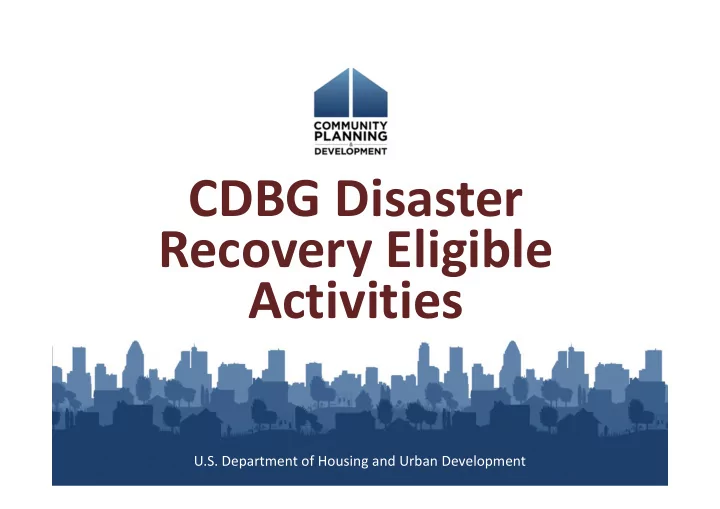

CDBG Disaster Recovery Eligible Activities U.S. Department of Housing and Urban Development
Welcome Goal for today: To get a broad understanding of the CDBG-DR eligible activities that grantees under Public Law 113-2 have at their disposal.
Overview • Discussion of Disaster Relief Appropriations Act, 2013 • Tie Back to the Disaster Requirement • Housing Activities • Infrastructure Activities • Economic Revitalization Activities • Preparedness and Mitigation Activities
Disaster Relief Appropriations Act, 2013 (P.L. 113-2) Appropriation Facts & Highlights • Funding - $16,000,000,000 in CDBG-DR funds • Funds will be available until September 30, 2017 • Funds will cover necessary expenses related to disaster relief, • long-term recovery, • restoration of infrastructure, housing, and economic revitalization • • Funding covers Hurricane Sandy and other disasters in 2011, 2012, and 2013
Tie Back to the Disaster Requirement All CDBG-DR activities must clearly address an impact of the disaster. This means a CDBG-DR eligible activity must: • Meet a national objective; – Activities Benefitting Low/Moderate Income Persons – Prevention/Elimination of Slums or Blight – Urgent Needs • Address a direct or indirect impact from the disaster in a county covered by a Presidential disaster declaration, and • Be located in a most impacted and distressed county as identified in the Notice.
Tie Back to the Disaster Requirement How This Requirement Can Be Shown • For physical losses – Damage or insurance estimates (the most effective tool) • For economic or other non-physical losses – Post-disaster analyses or assessments (documenting relationship between loss and disaster)
Tie Back to the Disaster Requirement Unmet Need Arising from a Previous Disaster • Funds may be used to address an unmet need that arose from a previous disaster, which was exacerbated by a disaster cited in the Appropriation. • If an impact or need originating from a disaster identified in the Appropriation is subsequently exacerbated by a future disaster, funds may also be used to address the resulting exacerbated unmet need.
Housing Activities Typical Housing Activities • New construction and rehabilitation – single family or multifamily units (including garden apartments, condominiums, and housing cooperative units). • Most often, grantees use CDBG-DR funds to rehabilitate damaged homeowner and rental units.
Housing Activities Housing Activities Not Damaged By the Disaster Grantees may fund new construction or rehabilitate units not damaged by • the disaster if the activity clearly addresses a disaster-related impact and is located in a disaster-affected area. Disaster-related impact effects • quality, • quantity, and • affordability of the housing stock • Disaster-related impact results in the inability of the existing stock to meet • post-disaster needs and population demands.
Infrastructure Examples of Infrastructure Activities Repair of damaged public facilities • Replacement of damaged public facilities • Relocation of damaged public facilities •
Economic Revitalization Wide Range of Economic Revitalization Activities Activities not limited to “special economic • development” activities under the HCD Act or to activities that create or retain jobs. Economic revitalization can include any activity • that demonstrably restores and improves the local or regional economy, such as addressing job losses.
Economic Revitalization Examples of Economic Revitalization Activities Providing loans and grants to businesses, • Funding job training, • Building education facilities to teach technical • skills, Making improvements to commercial/retail • districts, and Financing other efforts that attract/retain workers • in devastated communities.
Economic Revitalization Grantee Requirements For direct assistance to a business, funds may only be provided • to a small business, as defined at 15 U.S.C. 632(a) OR a business that the grantee can demonstrate that funding is both reasonable and critical to long-term recovery. Must address an economic impact caused by the disaster ( e.g ., • loss of jobs). As part of its needs assessment and Action Plan, the grantee • must clearly identify economic loss or need resulting from the disaster, and how proposed activities will address the expressed loss/need.
Preparedness and Mitigation Advantages of Preparedness and Mitigation Preparedness and mitigation measures for rebuilding • activities helps to ensure that communities recover to be safer, stronger, and more resilient. Preparedness and mitigation measures also reduce • costs in recovering from future disasters.
Preparedness and Mitigation Requirements Mitigation measures not incorporated into rebuilding • activities must be a necessary expense related to disaster relief, long-term recovery, and restoration of infrastructure, housing, or economic revitalization. Costs associated with mitigation measures may not • prevent the grantee from meeting unmet needs.
Questions?
Recommend
More recommend